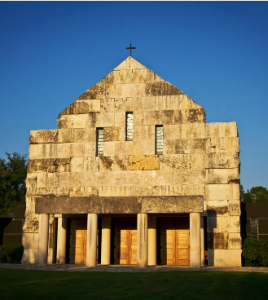Our Lady of Dallas Abbey Church is a genuine but contemporary example of Cistercian architecture, reflecting the Order’s traditional commitment to simplicity, poverty, and seclusion as well as its willingness to formulate its message for the modern world. It uses a medieval design and both traditional and modern materials to meet the contemporary needs of abbey, school, and community.
I LOVE CHANTING!
My little brother Christopher attended Cistercian Preparatory School here in the Dallas Metroplex before attending the United Sates Naval Academy. I especially remember visiting the chapel for the Sunday Gregorian Chant Conventional Mass. With Pope Frances’ (A Jesuit) current Historic visit to our beautiful and sacred country, I thought this would be the perfect time to share about this rare and beautiful experience that is happening right here in our great city.
The Gregorian chant is the oldest musical manifestation of the Occident and it has its roots in the songs of the old synagogues, since Jesus Christ`s times.
The first Christians and disciples of Christ, were converted Jewish that, persevering in prayer, continued to sing the psalms and songs of the Old Testament as they were used, although with other sense. As long as the Greek, not Jews and Romans were also becoming Christian, elements of the music and the Greek-French-Roman culture were being included to the Jewish songs.
The formation period of the Gregorian chant includes the centuries I to VI, reaching the peak in the centuries IX, X and XI, beginning of the Medium Age; it begins, then, its decadence.
The name is an homage to Pope Gregory I (540-604) that did a collection of pieces, publishing them in two books: Antiphonarium, group or referring melodies at the Canonical Hours, and the Graduale Romanum, containing Santa Mass`s songs. He also began the “Schola Cantorum” that gave great development to the Gregorian chant.
Starting from the initiative talent of D. Moquereau, at the end of XIX century, the Saint Pierre of Solesmes Monastery, in France, became the great center of studies and practice of the Gregorian chant. Its monks, at that time, led off a paleography work (the study of the old manuscripts) of Gregorian chant and a recovery of the signs written in the centuries VII and IX. Then, appears the Gregorian semiology, which is the interpretation of the signs, back to the source, establishing a more authentic interpretation of the Gregorian chant; among others it appears the talent work of Eugène Cardine, OSB.
At the beginning of XX century, Pope Pious X asks the Benedictine monks to make a modern edition of the manuscripts, appearing then the Vatican Edition. In 1985 another edition called “Graduale Triplex” with three notations of the Gregorian chant: the Vatican, the one of Laon (France) and the other of Saint Gaal (Switzerland).
When: Sundays @ 9AM
Where: 3550 Cistercian Road Irving, Texas
Cost: Free
Link: Cistercian Liturgy





